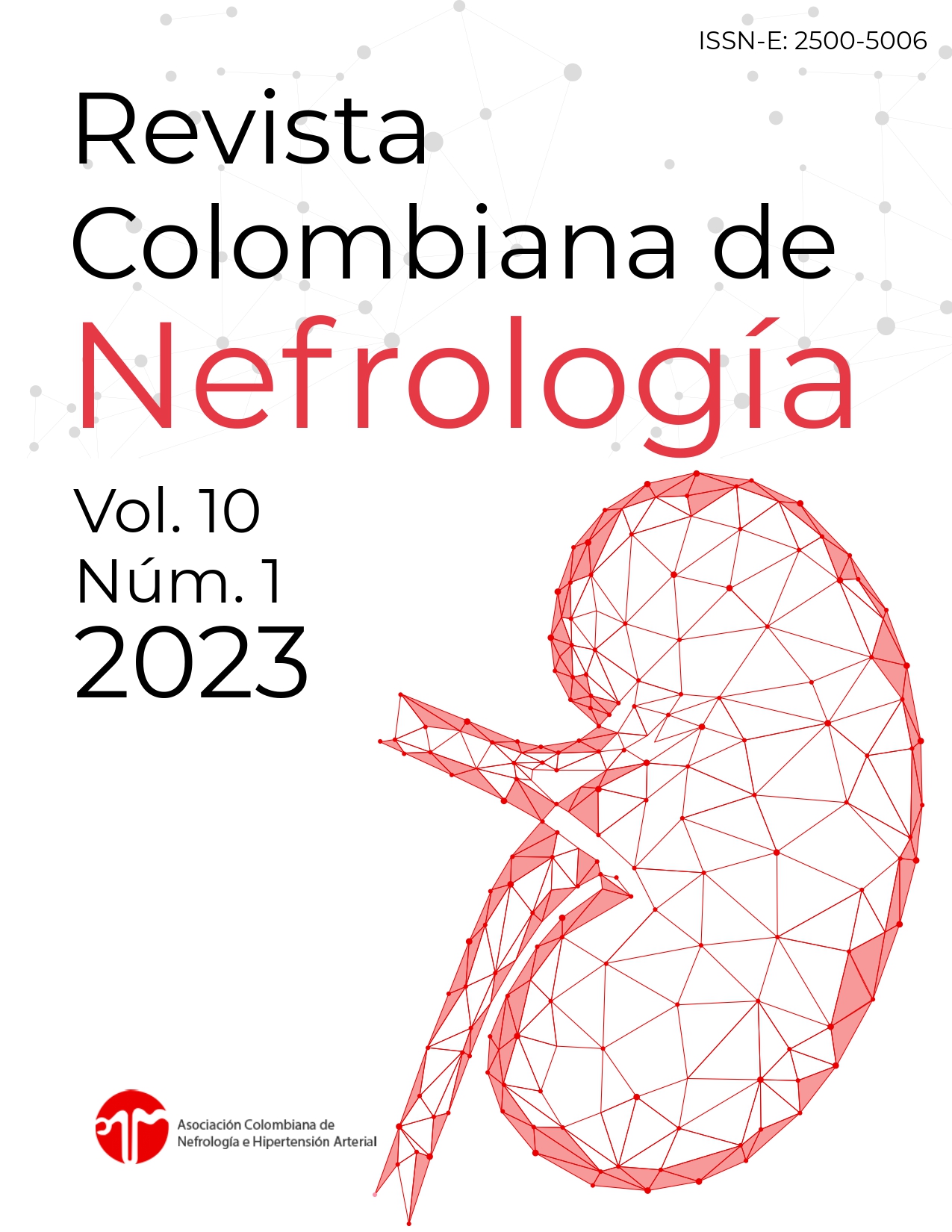Abstract
Introduction: Vascular access (VA) remains a major source of morbidity for hemodialysis patients (HD). Few data sources adequately capture longitudinal patency of the VA. This study aimed to evaluate VA failure and its related factors in HD patients.
Methods: A retrospective cohort study of 985 incident hemodialysis patients treated in clinics of BRCS in Colombia, from January 1rst ,2016, until December 3 of the same year, was done. The cohort's enrollment was on day 1 of HD, and with follow-up for up to 15 months. Association among a group of independent variables and time to failure of the VA was performed, and adjusted by baseline variables using a Cox regression model.
Results: A total of 985 patients were included in the study, requiring 1774 procedures of vascular access during follow-up. The mean age was 61 ± 15.6 years. At day 1, 15% were dialyzing with an arteriovenous fistula (AVF) or AVG; and at day 90, this proportion had increased to 70%. The rate of vascular access procedure was 1.95 per patients-year, 95% CI 1.86-2.04. The rate of vascular access failure was 0.66 per patients-year, 95% CI 0.61–0.72. Risk factors for failure in AVF/AVG were age > 65 (p= 0.008), diabetes (p= 0.019), female sex (p= 0.002) rural housing (p<0.0001) and higher hemoglobin (p= 0.021).
Conclusion: Vascular access failure and the requirement for procedures associated with it are frequent in the dialysis population. Several risk factors, some of them modifiable, are related to vascular access failure.
References
Vascular Access Work Group. Clinical practice guidelines for vascular access. Am J Kidney Dis. 2006;48 (Suppl 1): S248–273. https://doi.org/10.1053/j.ajkd.2006.04.040
Fluck R, Kumwenda M. Renal Association clinical guideline on vascular access for haemodialysis. Nephron Clin Pract 2011;118(Suppl 1):c225–c240. https://doi.org/10.1159/000328071
Lok CE, Huber TS, Lee T, Shenoy S, Yevzlin AS, Abreo K, et al. KDOQI clinical practice guideline for vascular access: 2019 Update. Am J Kidney Dis. 2020 ;75 (4 Suppl 2): S1-S1644. https://doi.org/10.1053/j.ajkd.2019.12.001
Pisoni RL, Arrington CJ, Albert JM, Ethier J, Kimata N, Krishnan M, et al. Facility hemodialysis vascular access use and mortality in countries participating in DOPPS: An instrumental variable analysis. Am J Kidney Dis. 2009;53(3):475–491. https://doi.org/10.1053/j.ajkd.2008.10.043
Canaud B, Combe C, Bragg-Gresham JL, Eichleay MA, Pisoni RL, Port FK. DOPPS estimate of patient life years attributable to modifiable hemodialysis practices in France. Nephrol Ther. 2008;4(4):256–265. https://doi.org/10.1016/j.nephro.2008.01.003
Pisoni RL, Young EW, Dykstra DM, Greenwood RN, Hecking E, Gillespie B, et al. Vascular access use in Europe and the United States: Results from the DOPPS. Kidney Int. 2002;61(1):305–316. https://doi.org/10.1046/j.1523-1755.2002.00117.x
Dhingra RK, Young EW, Hulbert-Shearon TE, Leavey SF, Port FK. Type of vascular access and mortality in U.S. hemodialysis patients. Kidney Int. 2001;60(4):1443–1451. https://doi.org/10.1046/j.1523-1755.2001.00947.x
Bradbury BD, Chen F, Furniss A, Pisoni RL, Keen M, Mapes D, et al. Conversion of vascular access type among incident hemodialysis patients: Description and association with mortality. Am J Kidney Dis. 2009;53(5):804–814. https://doi.org/10.1053/j.ajkd.2008.11.031
Malas MB, Canner JK, Hicks CW, Arhuidese IJ, Zarkowsky DS, Qazi U, et al. Trends in incident hemodialysis access and mortality. JAMA Surg. 2015;150(5):441–448. https://doi.org/10.1001/jamasurg.2014.3484
Ravani P, Palmer SC, Oliver MJ, Quinn RR, MacRae JM, Tai DJ, et al. Associations between hemodialysis access type and clinical outcomes: A Systematic review. J Am Soc Nephrol. 2013;24(3):465–473. https://doi.org/10.1681/ASN.2012070643
Monroy-Cuadros M, Yilmaz S, Salazar-Bañuelos A, Doig C. Risk factors associated with patency loss of hemodialysis vascular access within 6 months. Clin J Am Soc Nephrol. 2010;5(10):1787–1792. https://doi.org/10.2215/CJN.09441209
De Pinho NA, Coscas R, Metzger M, Labeeuw M, Ayav C, Jacquelinet C, et al. Predictors of nonfunctional arteriovenous access at hemodialysis initiation and timing of access creation: A registry-based study. PLoS One. 2017;12(7):1–15. https://doi.org/10.1371/journal.pone.0181254
Cuenta de Alto Costo. Situación de la enfermedad renal crónica, la hipertensión arterial y la diabetes mellitus en Colombia 2019. [Internet] [Accessed November 24, 2020] Available in: https://cuentadealtocosto.org/site/download/situacion-de-la-enfermedad-renal-cronica-la-hipertension-arterial-y-diabetes-mellitus-en-colombia-2019/
Wei LJ, Glidden D V. An overview of statistical methods for multiple failure time data in clinical trials. Stat Med. 1997;16(8):833–839. https://doi.org/10.1002/(SICI)1097-0258(19970430)16:8%3C833::AID-SIM538%3E3.0.CO;2-2
Astor BC, Eustace JA, Powe NR, Klag MJ, Fink NE, Coresh J, et al. Type of vascular access and survival among incident hemodialysis patients: The choices for healthy outcomes in caring for ESRD (CHOICE) Study. J Am Soc Nephrol.2005;16(5):1449–1455. https://doi.org/10.1681/ASN.2004090748
Ethier J, Mendelssohn DC, Elder SJ, Hasegawa T, Akizawa T, Akiba T, et al. Vascular access use and outcomes: An international perspective from the dialysis outcomes and practice patterns study. Nephrol Dial Transplant. 2008;23(10):3219–3226. https://doi.org/10.1093/ndt/gfn261
Bashar K, Zafar A, Elsheikh S, Healy DA, Clarke-Moloney M, Casserly L, et al. Predictive parameters of arteriovenous fistula functional maturation in a population of patients with end-stage renal disease. PLoS One. 2015;10(3):1–15. https://doi.org/10.1371/journal.pone.0119958
Yoo DW, Yoon M, Jun HJ. Successful access rate and risk factor of vascular access surgery in arm for dialysis. Vasc Spec Int. 2014;30(1):33–37. https://doi.org/10.5758/vsi.2014.30.1.33
Allon, M, Robbin ML. Increasing arteriovenous fistulas in haemodialysis patients: Problems and solutions. Kidney Int. 2002;62:1109–1124. https://doi.org/10.1111/j.1523-1755.2002.kid551.x
Kim SM, Ko HK, Noh M, Ko GY, Kim MJ, Kwon TW, et al. Factors affecting patency following successful percutaneous intervention for dysfunctional hemodialysis vascular access. Ann Vasc Surg. 2018;47:54–61. https://doi.org/10.1016/j.avsg.2017.08.003
Alencar de Pinho N, Coscas R, Metzger M, Labeeuw M, Ayav C, Jacquelinet C, et al. Predictors of nonfunctional arteriovenous access at hemodialysis initiation and timing of access creation: A registry-based study. Aliseda A, editor. PLoS One. 2017;12(7):e0181254. https://doi.org/10.1371/journal.pone.0181254
Balhara KS, Fisher L, El Hage N, Ramos RG, Jaar BG. Social determinants of health associated with hemodialysis non-adherence and emergency department utilization: A pilot observational study. BMC Nephrol. 2020;21(1):1–9. https://doi.org/10.1186/s12882-019-1673-7
Chand DH, Teo BW, Fatica RA, Brier M, Medical Review Board of The Renal Network, Inc. Influence of vascular access type on outcome measures in patients on maintenance hemodialysis. Nephron Clin Pract. 2008;108(2):c91-8. https://doi.org/10.1159/000113525

This work is licensed under a Creative Commons Attribution-NonCommercial-NoDerivatives 4.0 International License.


